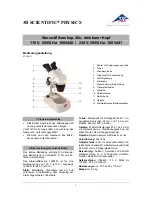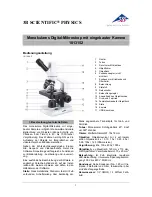
Usually, the sample is put on the stage under the clips (5).
7
)
Condenser
(
24
)
:
Revolve the knob (23), the gear-rack mechanism makes the condenser up or down to
suit for the different objectives.
8
)
Plate for Numerical Aperture
(
10
)
:
The numerical aperture of the iris diaphragm built-in can be adjusted from Ø2mm to
Ø30mm by turning the plate (10). When the diameter of iris diaphragm is 70-80% of the
objective’s numerical aperture, the image observed is sharp in contrast. This moment,
look into the tube without eyepiece, and you can see the image of iris diaphragm. The
center of the diaphragm can be adjusted by rotating the black-head screws (9) without any
tools as following steps:
a) Turn the 4X or 10X objective in working;
b) Turn the plate (10) to small the diaphragm diameter;
c) Lower the diaphragm to make its image sharp by rotating the knob (23);
d) Rotate the screws (9) to concentre the image of the diaphragm with the eyepiece
viewing field.
Usually, it is adjusted coaxial before the microscope is finished.
9) Polarizer Plate (13):
The
position of the polarizer in microscope is fixed. Turn the plate (13), the deflexion
angle of the polarizer will change. Scale on the graduated ring will tell you the angle the
polarizer turned.
10
)
Illumination System
:
The input voltage for the microscope may be 220V/50Hz, or 110V/60Hz. So you should
make sure which voltage is used during purchasing. At same time you should tell us the
plug type of the electrical wire.
The illuminator is normally 6V/20W halogen lamp. If you need, we also provide you
3.5V/1W high brightness LED lamp.
Caution:
----Before change a bulb, ensure that the microscope has been disconnected
with the power source;
----The bulb must be the same specifications as the old one;
----When the illuminator is halogen lamp, the body near the lighting source may
be very hot. Don’t worry, but it is necessary to take the combustible material (such
as gasoline, paper, plastic and cloth) far away from the microscope. When change it,
wait until it is cool enough. Otherwise the hot bulb will burn your fingers.
----Don’t leave any dust and fingerprints on the bulb. Otherwise it may affects its
life and illuminating efficiency.
11
)
Focusing System
:
It is coaxial coarse and fine focusing system with rack and pinion mechanism. Its
focusing range is 15mm. Decelerate through the multistage precision gear box, its
precision of fine focusing is 0.01mm/scale.
P.4



























